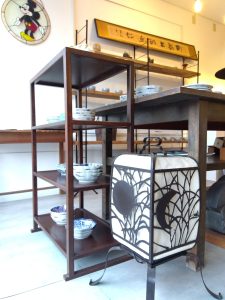電気のありがたみに感謝です(愛知県名古屋市千種区姫池通 骨董買取 古美術風光舎)
2023.12.15
みなさまこんにちは、スタッフTでございます。
今朝は雨のせいか、薄暗くなかなか布団から出られませんでした。夕方、日が落ちるのも早くなりましたね。こういったお天気で薄暗い時は、いつでもどこでも、明るく照らしてくれる照明のありがたみを感じます。

今では夜でも明るくしてくれる電気ですが、昔は電気なんて便利なものはありません。縄文時代から江戸時代頃は電気のない生活をしていました。電気やガスはもちろんランプなんて高級なものは一切なかった昔の時代。日が沈むと外はほぼ闇に包まれて、月の明るさしかなかったでしょう。ただ、当時の月の明かりは、今とは比べ物にならないほど明るく、むしろ月が出ている時は夜道も歩けるほどだったようですが。
昔の照明といえば蝋燭ですが、仏教伝来とともに日本にもたらされたといわれ、奈良・平安時代には宮中や寺院といった特別な場所で使われていました。当時はすべて輸入品で庶民には手が出ない代物です。
蝋燭が広く普及するまでの時代は、人々は燃料として植物や動物の油を利用した「灯油」を使用しました。これは「とうゆ」ではなく「ともしあぶら」と読みます。
灯油のなかった時代には、胡麻油・えごま油・菜種油などの植物系油を燃料として使っていました。また、鰯・鯨などの「魚油」と呼ばれる動物系の油も使われていたそうです。江戸時代に広まったとされる植物系の油は匂いも少なくて人気でしたが、米の値段の3倍もするとても高級品でした。ですので、庶民は植物油に比べて半分以上も安い魚油を利用してました。安い魚油は、魚臭くなる、煤(すす)がたくさんでるなどデメリットもあったようですが、庶民には貴重なものでした。
1879年にエジソンが京都の竹を使って白熱電球を実用化するまでは、太陽とともに暮らす「早寝早起き」はやむを得ないものだったのでしょうね。
時代が変わるにつれ、照明器具も変化していきますが、奈良時代にはもうロウソクがあったのには驚きです。そして大きな戦乱が起こらなかった江戸時代、日本のあかり文化が花開き、様々な新しい照明器具が普及します。人々の生活があかりで彩られるようになった照明器具の一つが「行燈(あんどん)」です。
行燈(あんどん)に似た言葉に、灯籠(とうろう)・提灯(ちょうちん)がありますが、その違いはなんでしょう?
「灯籠」は主に外で使用された、今でいう街灯です。灯籠とは「灯り」の「カゴ」という意味で、その名のとおりロウソクの火が風で消えないよう、周囲を囲った道具です。素材は木や金属などさまざまですか、石で作られたものはとくに石灯籠と呼ばれます。
室外に設置される灯籠に対し、主に室内で使用されていたのが「行燈」です。ロウソクや、油に浸した布に火をつけて利用しました。室内で利用するので軽い木製のものが多く、火の回りは風よけの紙で覆われていました。枕元に置いておけるほど小さな行燈は、とくに有明行燈と呼ばれるそうです。
行燈と同じように紙で覆われていますが、持ち運びできるよう進化したのが「提灯」です。軽くて、さらに持ち手がついています。持ち運びが簡単なように、使わないときは折りたたんでおくことができました。
当店にも素敵な行燈がございますが、長くなりましたので、また次回。
ではでは、また。
Hello everyone, this is Staff T.
This morning it was too dark to get out of the futon, probably because of the rain. The sun is setting early in the evening. Here in Nagoya, sunrise is around 6:50 a.m. and sunset is around 4:40 p.m. When the weather is dim, I feel thankful for the bright lights that illuminate the room whenever and wherever I am.
Nowadays, electricity brightens up the night, but in the olden days, electricity was not such a convenient thing. From the Jomon period to around the Edo period, people lived without electricity. In the old days, there was no electricity, gas, or even lamps of any luxury. Once the sun set, it was almost always dark outside, and there would have been only the brightness of the moon. However, the moonlight in those days was much brighter than that of today, and it was even possible to walk on the street at night when the moon was out.
Candles were used for lighting in the past, but they are said to have been brought to Japan with the arrival of Buddhism, and were used in special places such as palaces and temples during the Nara and Heian periods. In those days, all candles were imported and inaccessible to the general public.
Before the widespread use of candles, people used “kerosene,” made from plant and animal oils, as fuel. This is read as “to-moshi-abura,” not “to-yu.
In the absence of kerosene, people used plant-based oils such as sesame oil, sesame oil, and rapeseed oil as fuel. Animal oil called “fish oil” such as sardine and whale oil was also used. Vegetable oil, which is said to have spread during the Edo period, was popular because it had little smell, but it was a very expensive product, costing three times the price of rice. Therefore, common people used fish oil, which was more than half the price of vegetable oil. Cheap fish oil had some disadvantages, such as smelling like fish and producing a lot of soot, but it was valuable to the common people.
Until 1879, when Edison put an incandescent light bulb to practical use using bamboo from Kyoto, “going to bed early and getting up early” to live with the sun must have been unavoidable.
As time went by, lighting fixtures also changed, but it is surprising that there were already candles in the Nara period. In the Edo period (1603-1867), when there were no major wars, Japan’s lighting culture flourished and various new lighting fixtures became popular. One of the lighting fixtures that came to color people’s lives with light was the “andon,” a type of paper lantern that resembles an andon.
Similar words to “andon” include “toro” and “chochin,” but what is the difference between them?
Lanterns were mainly used outside, and are what we now call streetlights. The word “lantern” means “basket” of “light,” and as the name implies, it is a tool used to surround a candle to keep it from being extinguished by the wind. Lanterns are made of various materials, including wood and metal, but those made of stone are called stone lanterns in particular.
While lanterns were installed outside, “andon” were mainly used indoors. They were lit by candles or cloth soaked in oil. Since they were used indoors, most were made of lightweight wood, and the area around the fire was covered with paper to protect it from the wind. Andon that were small enough to be left by a person’s bedside were called Ariake Andon.
Chochin, which are covered with paper like andon, have evolved to be portable. It is light and has a handle. They could be folded up when not in use for easy transportation.
We also have some nice andon in our store, but this is a long story, so I will tell you more next time.
See you next time.
*******************
ご実家の整理やお片付けなどをされている方のご相談などが多くございます。
お片付けなどくれぐれもご無理のないようになさってくださいませ。
風光舎では古美術品や骨董品の他にも絵画や宝石、趣味のお品など様々なジャンルのものを買受しております。
お片付けをされていて、こういうものでもいいのかしらと迷われているものでも、どうぞお気軽にご相談下さいませ。
また風光舎は、出張買取も強化しております。ご近所はもちろん、愛知県内、岐阜県、三重県その他の県へも出張いたします。
まずは、お電話お待ちしております。
愛知県名古屋市千種区姫池通
骨董 買取
【古美術 風光舎 名古屋店】
TEL052(734)8444
10:00-18:00 OPEN
#出張買取#骨董#古美術#骨董品#絵画#版画#茶道具#刀剣#彫刻

